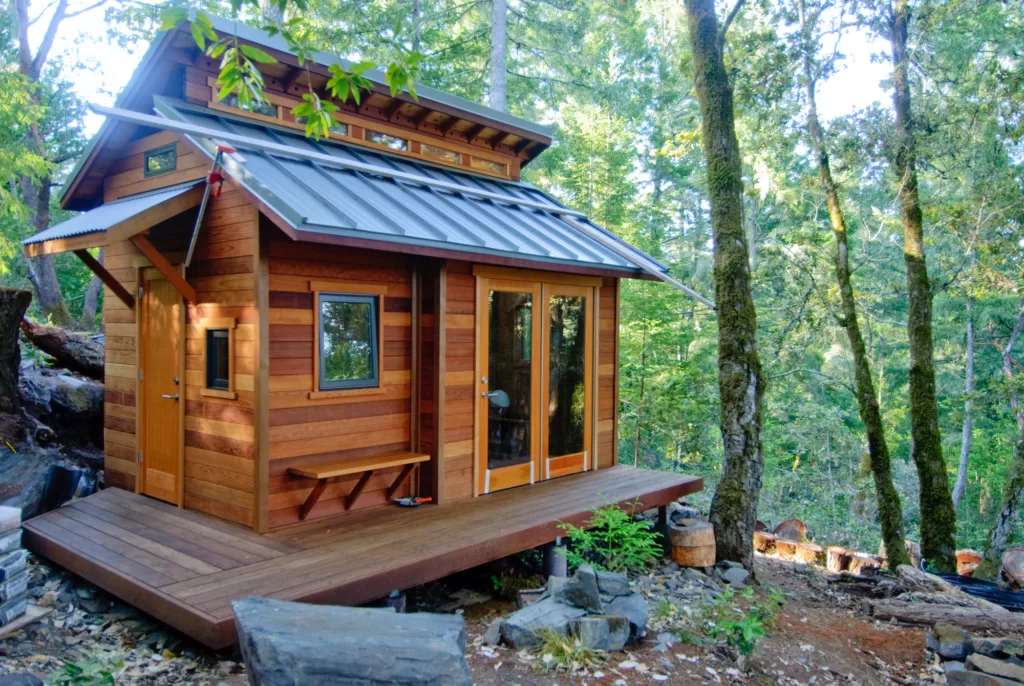In recent years, the tiny house movement has become a cultural and social phenomenon. It has not only captured the attention of individuals tired of the 9-5 grind but has also tapped into the collective consciousness of consumers concerned with sustainability, financial freedom, and innovative design.

Though tiny houses are typically around 100 to 400 square feet, the design concepts and exterior aesthetics are just as important as those for larger homes.
The economic benefits of tiny house living are undeniable. In a society where mortgage debt and rising costs of living have become pressing concerns, the tiny house movement offers a breath of fresh air.
Notably, 89% of tiny homeowners say they are less concerned about money after downsizing. This isn’t surprising. The average cost of building a tiny house is roughly $23,000, compared to a standard U.S. home that could cost up to $272,000 according to Zillow.
Tiny houses offer a solution to the global issue of resource depletion. Since they are designed to make the most out of small spaces, tiny homes often incorporate smart technology, energy-efficient appliances, and renewable energy sources.
This makes the tiny house lifestyle one of the most sustainable ways to live. With fewer resources needed for building materials and energy, they are significantly less damaging to the environment than traditional homes.
Tiny house communities have sprung up in various parts of the world, offering a more intimate and communal style of living. Residents often share common areas like gardens, communal kitchens, and laundry facilities.
The sense of community in these spaces fosters a lifestyle that is collaborative rather than isolated, providing opportunities for relationships and shared experiences that many find lacking in traditional housing setups.
Read Also :
While interior designs often steal the limelight, the tiny house exterior shouldn’t be overlooked. The external part of a tiny house is what makes the first impression.
With limited space, innovative solutions are crucial. For instance, retractable roofs for stargazing, foldable decks for extended living space, and even exterior storage spaces cleverly tucked into the design are not uncommon.
The concept of mobility and flexibility is one of the defining traits that sets tiny house living apart from traditional homeownership. Unlike a stationary home anchored to a single plot of land, many tiny houses are built on trailers, allowing for easy relocation whenever the whim strikes.
This offers unparalleled freedom to move—be it for job opportunities, lifestyle changes, or just a change of scenery—without the logistical and financial nightmares usually associated with moving. Whether you’re a remote worker, an adventurer at heart, or someone who just prefers not to be tied down, the mobility that comes with a tiny house can be a significant quality-of-life upgrade.
One of the challenges that tiny house owners face is local laws and zoning regulations. Since this is a relatively new phenomenon, many areas do not have proper zoning laws that address tiny houses.
This leads to complications in placing your tiny house, especially if you wish to maintain a semi-nomadic lifestyle. Therefore, it is essential to thoroughly research the laws in your desired location before making the leap.
Before diving into tiny house living, here are a few things to consider:
Be realistic about your space needs, including storage, and any family members or pets that will be sharing the space with you.
Though less than a traditional home, tiny houses still have utility bills. Research options for off-grid living if you wish to lower these costs further.
Tiny living can often mean giving up certain luxuries or conveniences. Be prepared for a lifestyle change.
Although the tiny house market is growing, the resale value of a tiny home can be a little unpredictable.
The price and legality of your tiny home will vary significantly depending on the state, county, and even neighborhood you choose to place it in.
The tiny house movement presents a compelling alternative to traditional living, offering financial freedom, a reduced environmental footprint, and a community-oriented lifestyle. While small in square footage, these innovative homes are big on design, functionality, and aesthetic appeal.
Just as with any home, your tiny house exterior can be a unique expression of your personality and lifestyle choices, serving as an introduction before guests even step through the door.
From the latest in design innovation to building sustainable, community-centric models, the tiny house movement is much more than a trend; it is a lifestyle revolution that is gaining momentum by the day.
As we continue to look for ways to simplify our lives and make sustainable choices, tiny houses offer a viable solution that is efficient, affordable, and in many ways, liberating.
So, if you’re considering taking the plunge into a simpler, more sustainable lifestyle, perhaps it’s time to look beyond square footage and delve deeper into what makes a house a home.